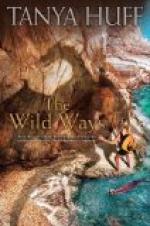They passed antelopes anchored in the shade; hartebeest, impala, and roan after their kind. They heard the click of horn and the stamp of hoof, but troubled not. They passed the place where a leopard lay asleep up a tree, and saw a devil’s whip of a ten-foot mamba snake—and the bite of that same is a sixty-second short cut to the grave—flee before them as if they, and not it, were death incarnate. Once a serval cat, all legs and ears and agility, stood in their path to listen to the funny chuckling, whistling noises, but fled when it saw the little, low ratel as if it had seen a ghost.
But always undeterred by anything in the way, engrossed utterly on the task in view, the dusky bird flew ahead, calling the ratel on with its harsh cry; and always the ratel, unhurried and cool, jogged along in its wake, answering, and whistling, and chuckling away to it, as if convulsed with inward merriment. Perhaps he was. It was a strange procession, anyway, and one you don’t look for every day in the week, even in Africa, the land of mysteries and surprises.
Finally, the bird stopped; and the ratel looked, and saw that it was flitting round the base of a big mimosa. Enough! He hurried a little at last. Next moment he was nearly hidden under a continuous stream of earth and dust flying back from his amazing foreclaws, and a whirling, whirring vortex of perfectly demented bees, whose nest, that had been weeks in the building, was dissolving in seconds under the trowel-like scoopings of those fearful claws.
Honey! Honey! Honey!
That was it. That was the magic word the bird, who was a honey-guide by name, had shouted to the ratel, who was a honey-badger, you remember; and honey-bees they were that made the air delirious.
The bird, with the quick eye of a detective, had located the hole of the nest, but having no trowel, forthwith fetched the ratel, who had, and together they fed, the beast on honey, and the bird on the grubs in the combs.
And the bees? Oh, they don’t count! At least, they might have been house-flies for all the notice the ratel took of them, save now and then to bunch a dozen or so off his cowled head carelessly. Yet they would probably have nearly killed us.
It was about this time that the bull-gnu appeared, tramping steadily towards them; a rugged, rough renegade of the wilderness; a ruffian kicked—or, rather, horned—out of some herd forever, and, for his sins, doomed always to face the risks of life alone, or in the companionship of other male outlaws of soured temper like himself—almost always male; the female wild seems guiltless of law-breaking, or is under a banner of protection if it is not. Such “rogues,” as men call them, are not gentlemanly, as a rule. And, by the way, you know the gnu, of course, alias wildebeest? The head of a very shaggy buffalo, the horsy mane, the delicate, strong, sloping antelope body, the long, mustang-like tail, and the strange, twisted, unconventional character, half-fierce, half-inquisitive.




